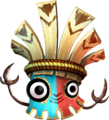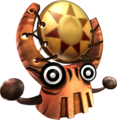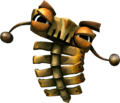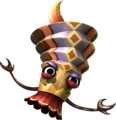Tiki Tak Tribe: Difference between revisions
mNo edit summary |
(→Trivia) |
||
| Line 41: | Line 41: | ||
*Most of the Tiki Tak Tribe resemble various musical instruments, with many of the lower-ranking Tikis resembling a drum. | *Most of the Tiki Tak Tribe resemble various musical instruments, with many of the lower-ranking Tikis resembling a drum. | ||
**This also applies to the Tiki leaders who possess the various bosses. The particular instrument the Tiki resembles also plays in the music of the boss it possesses. | **This also applies to the Tiki leaders who possess the various bosses. The particular instrument the Tiki resembles also plays in the music of the boss it possesses. | ||
*Traditionally, Tikis are associated with Polynesian culture, however the Tiki Tak Tribe seems to draw more influence from African tribal culture instead. | *Traditionally, Tikis are associated with Polynesian culture, however the Tiki Tak Tribe seems to draw more influence from African tribal culture instead. This is because of the patterns and vibrant colors each Tiki has. | ||
<br clear=all> | <br clear=all> | ||
Revision as of 11:28, November 3, 2012
The Tiki Tak Tribe consists of the main antagonists in the Wii game Donkey Kong Country Returns.
History
In the opening of the game, the Tiki Tak Tribe are seen emerging from rocks that are spewed out of the volcano on Donkey Kong Island when the giant statue rises out of it, causing it to erupt. Moments after landing, they hypnotize the animals of the island, who proceed to steal Donkey Kong's Banana Hoard. A Tiki then drops into Donkey Kong's house, but he is unaffected by their hypnotic powers. They then pose as the main villains and enemies in the game's levels, and can be considered the game's equivalent of Kremlings.
Physical Appearance
Most of the Tiki Tak Tribe resemble floating wooden tiki masks, and many are adorned with colored feathers. However, they come in a variety of colors and shapes, such as the Tiki Goons that resemble bongos or drums and Tiki Buzzes that resemble birds with wooden wings to their sides. The main servants of Tiki Tong are notable to resemble musical instruments, and most of them have a pair of skinny, twig-like arms.
Special Powers and Abilities
The Tikis are shown to have many abilities. They are shown to be quite agile, for masks. Some are able to float freely in the air, while others, like the Tiki Buzzes, have the ability to fly by fluttering their wings. Other Tikis have the ability to resist the physical attacks of Donkey Kong and Diddy Kong, such as the Tiki Doom and Tiki Tank, which can only be defeated by throwing a barrel at them or with the help of an Animal Buddy like Rambi the Rhinoceros. The Tikis are also known to use fire. Despite apparently being made from wood, most Tikis are resistant to be engulfed by fire and some use this element against the Kongs to attack and defend. Tiki Torches are an example. Tiki Tong's main servants possess the ability to hypnotize other animals and control them. However, it seems the ability doesn't work on all the animals, as Donkey Kong and Diddy Kong are not affected by their powers as seen in the intro of the game. Although they count with these powers and abilities, all the members of the Tiki Tak Tribe need bananas because these fruits are the Tikis' main source of power. As seen in Donkey Kong Island's factory, a Tiki can come to life when a mashed-up banana is incorporated into its body. This is further demonstrated with the final battle with Tiki Tong, where they merge with Tiki Tong after he turns the bananas into banana fluids and transform into his hands, making him stronger for his battle against the Kongs.
Gallery
- TikiGoon.PNG
- TikiTank.PNG
Kalimba Tiki, who hypnotizes Mugly.
The Maraca Tiki Trio, who hypnotize the Scurvy Crew.
Gong Tiki, who hypnotizes Stu.
Banjo Tiki, who hypnotizes Mole Miner Max.
Panpipe Tiki, who hypnotizes Mangoruby.
Xylophone Tiki, who hypnotizes Thugly.
Accordion Tiki, who hypnotizes Colonel Pluck.
Tiki Tong, the leader of the tribe.
Trivia
- Most of the Tiki Tak Tribe resemble various musical instruments, with many of the lower-ranking Tikis resembling a drum.
- This also applies to the Tiki leaders who possess the various bosses. The particular instrument the Tiki resembles also plays in the music of the boss it possesses.
- Traditionally, Tikis are associated with Polynesian culture, however the Tiki Tak Tribe seems to draw more influence from African tribal culture instead. This is because of the patterns and vibrant colors each Tiki has.









